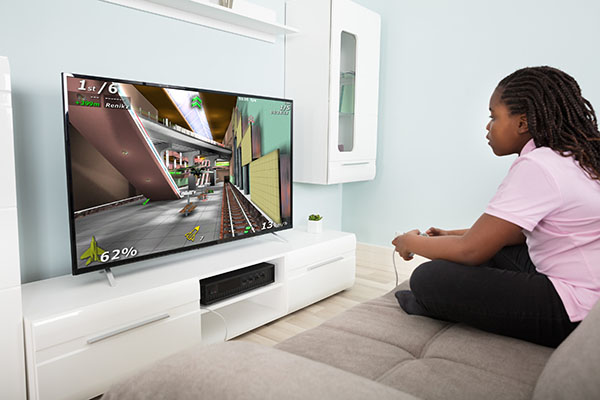By Caileigh Flannigan
Contributing Writer
 The unfortunate reality of modern childhood is that it involves more screen time than playtime. Children at very young ages are spending more time than ever, immersed in screens such as tablets, computers, and smart-phones.
The unfortunate reality of modern childhood is that it involves more screen time than playtime. Children at very young ages are spending more time than ever, immersed in screens such as tablets, computers, and smart-phones.
The outcome is that children are not getting exposure to appropriate play and learning activities, which in turn. affects their mental well-being, physical health, and overall development.
With recent screen time guidelines, put forward by both the American Pediatric Society and the Canadian Paediatric Society, families should begin to think about the impacts of media use on their children.
This article will discuss appropriate screen time for young children and provide caregivers with tips on how to unplug at home.
Particularly in early childhood (birth to 5 years), the brain is developing quickly and it is very sensitive to environmental input. This early brain development is the foundation to later cognition and learning.
Too much screen time, at early ages, can impede the development of cognitive, social, physical, and emotional development. Unfortunately for today’s children, the increased use of screen time is becoming part of the routine in family homes.
In North America, children spend about three hours a day watching television and another 2-4 hours on other screens such as computers, laptops, tablets, and smartphones. That’s a total of five-seven hours per day engrossed in screens! Children between 3-5 years of age spend approximately 2 hours per day in front of screens.
In the US, rates of mobile use among 2 to 4-year-olds increased from 39 percent to 80 percent, between 2011 and 2013, and children between 8 months and 8 years of age are exposed to nearly 4 hours of background TV daily.
Children in Canada are supposed to be getting at least 60 minutes of daily moderate physical activity. Despite these recommendations, only 9 percent of 5 to 17-year-olds are meeting that target.
These facts are alarming, especially for children between 0 and 5 years of age. With increased media use, time is taken away from beneficial activities that promote a healthy lifestyle. Children are not experiencing social interaction and engagement with family and friends, have less sleep at night, and are not spending time engaged in outdoor play.
If children are happy and content using screens and parents receive a bit of a break, then what’s the issue? The issue is that with too much exposure to screens, children are not getting enough time to play, learn, interact with others, or sleep.
The decrease in these important areas leads to impediments and negative risks to children’s development and health. Here are some ways in which too much screen time and a lack of healthy activities impact children:
Psychosocial Risks
Increased screen time is displacing face-to-face interactions with family members. High levels of screen time at age 2 are associated with social isolation, aggression, and antisocial behaviors in middle childhood.
Language Delays
Preschool children who are not provided opportunities to play with traditional toys like blocks, and instead play with more technological toys, have less vocalization toward parents. Young children less than 12 months old exposed to 2 hours a day of screen time had significant language delays.
Physical Health
Children who watch a lot of television in early years are at a higher risk of becoming overweight. Children who watch just 1 hour per day of TV are 50 percent more likely to be overweight than children who watched less.
Impediments with Life Skills
Children who spend more time engaged with screens are less able to accomplish age-appropriate life skills such as tying their shoes, riding a bike, or swimming. Preschool children who are exposed to more screen time than playtime are less likely to be able to build with blocks.
Poor Sleep Quality
Increased screen time has been linked with poor sleep quality and quantity, and these sleep disturbances impact brain development and correlate with increased behavioral problems. Lack of sleep has also been associated with physical concerns such as diabetes and obesity.
Advertising Concerns
Watching TV involves advertisements for unhealthy foods, which encourages snacking and increases overall food intake.
What amount of screen time is appropriate for children? How do you know how much screen time to allow and what to limit? Here are some recommendations from the American Academy of Pediatrics and the Canadian Paediatric Society:
- For children under 2 years, screen time is not recommended.
- For children 2-5 years, limit screen time to 1 hour per day of high quality and educational programming.
- Do not make screen time a part of child care or supervision for children under 5 years of age.
- Parents should watch television with children 2-5 years to support them in understanding what they are viewing.
- For children 6 and older, limit screen time consistently and monitor the types of media they are exposed to.
- Find the balance between screen time and behaviors that are important to health (sleep, physical activity, social engagement).
Despite evidence that suggests overexposure to screens hinders children’s development and poses dangerous risks to their mental and physical health, there are potential benefits to letting children (over age 2) use screens.
However, these benefits come from the right sort of screen time and finding that balance between screen time and healthy behaviors. It is important to distinguish between different types of screen use.
For example, sitting and watching television for 2 hours is not the same as playing a learn-to-read game on a tablet, which is not the same as killing zombies on a computer or game console.
Therefore, the benefits come from the type of content that children are exposed to on their screens. For example, a screen that has age-appropriate, educational, goal-oriented content is more likely to be beneficial than a show that models aggressive and violent behavior.
Here are some tips for appropriate screen use and content:
- Do your research and find out what apps, television shows, movies, e-books, etc., have high-quality programming and material.
- Choose something that is developmentally appropriate for your child’s age.
- Teach your child about Internet safety and cyberbullying.
- Explain commercials to your children through conversations about money and happiness.
- Consider the types of screen time for your children. For example, instead of an hour of TV, opt for an educational app that is backed up by research.
We know that screen time has a significant impact on today’s children. However, parents can follow these simple tips to ensure the most appropriate exposure to screens that will provide optimal outcomes for their children:
- Be Consistent with Limits. Make sure to offer the same amount of screen usage every day for your child. For example, half an hour of screen time in the morning, another half an hour at night.
- Parents, You Set the Example. You can model good screen behavior for your children by putting down your tablets and cell phones during family time.
- Avoid Background TV. When not in use, turn off the television to avoid the distractions of TV and normalizing its use.
- Encourage Other Activities. As a parent, you can model and suggest healthy alternatives such as outdoor play, reading a book, crafts, or board games.
- Encourage Other Toys. Find toys that promote creativity and curiosity such as craft supplies, clay, blocks, or loose parts.
- Play with the Kids. Take a little bit of time each day to get down on the floor with your children and interact and communicate.
- Be a Good Observer, Listener, and Asker. Be more involved in your children’s lives by asking questions, listening to their stories, and observing and commenting on their non-screen time play activities.
- Maintain Daily Screen-Free Times. Make sure that parts of the day are completely screen-free. For example, family meals, family game nights, and bedtime.
- Become Media-Literate. Understand television show/tablet game ratings, educational vs. non-educational content, and high-quality vs. low-quality programming.
Screen time can pose many negative risks to children’s health and overall development. However, there are ways for parents to promote a healthier family lifestyle and manage their children’s screen time.
Remember to find the balance between screen time and activities that are crucial to learning and development such as physical activity, outdoor play, creativity, sleep, and face-to-face interaction.
Here are some more resources for you and your family:
Creating Your Own Family Media Plan
Finding Ways to Stay Active
Media and Children Communication Toolkit
Picking the Right Educational App
Caileigh Flannigan is a play practitioner who uses forms of play as a way to promote children’s development and emotional healing. She is an outdoor play and loose parts researcher who is spreading the word about the importance of free play in natural environments.
 Pride News Canada's Leader In African Canadian & Caribbean News, Views & Lifestyle
Pride News Canada's Leader In African Canadian & Caribbean News, Views & Lifestyle







